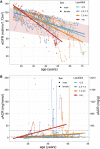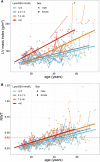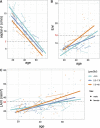Early Risk Stratification for Natural Disease Course in Fabry Patients Using Plasma Globotriaosylsphingosine Levels
- PMID: 37499686
- PMCID: PMC10578638
- DOI: 10.2215/CJN.0000000000000239
Early Risk Stratification for Natural Disease Course in Fabry Patients Using Plasma Globotriaosylsphingosine Levels
Abstract
Background: Fabry disease is a very heterogeneous X-linked lysosomal storage disease. Disease manifestations in the kidneys, heart, and brain vary greatly, even between patients of the same sex and with the same disease classification (classical or nonclassical). A biomarker with a strong association with the development of disease manifestations is needed to determine the need for Fabry-specific treatment and appropriate frequency of follow-up because clinical manifestations of the disorder may take decennia to develop.
Methods: We investigated the levels of plasma lysoGb3 levels over time and its association with disease manifestations and disease course in 237 untreated patients with Fabry disease (median age 42 years, 38% male) using linear mixed-effect models.
Results: LysoGb3 levels are stable over time in plasma of untreated patients with Fabry disease. Higher levels of lysoGb3 were associated with steeper decline in eGFR ( P = 0.05) and a faster increase in albuminuria (measured as the urinary albumin-to-creatinine ratio, P < 0.001), left ventricular mass (measured on echocardiography, P < 0.001), left atrial volume index ( P = 0.003), and Fazekas score ( P = 0.003). In addition, regardless of age, higher lysoGb3 levels were associated with higher relative wall thickness ( P < 0.001) and unfavorable functional markers on echocardiography, including septal mitral annular early diastolic velocity (e', P < 0.001) and the ratio of early transmitral velocity (E) to e' (E/e', P = 0.001).
Conclusions: In an individual patient with Fabry disease, the plasma lysoGb3 level reached a specific level in early childhood which, in the absence of Fabry-specific treatment, remained stable throughout life. The level of lysoGb3 in untreated patients was associated with nearly all Fabry-specific disease manifestations, regardless of the sex of the patient.
Copyright © 2023 by the American Society of Nephrology.
Conflict of interest statement
M.M. Brands reports research funding from Intrabio and serving as principal investigator at the Amsterdam site for the study: N-Acetyl-L-Leucine for Niemann-Pick Disease, Type C (NPC). M. el Sayed is involved in a premarketing study with Indorses; all financial arrangements are made through AMC Research BV. CH.E. Hollak and M. Langeveld are involved in premarketing studies with Genzyme, Idorsia, and Protalix. S.J. van der Veen was involved in premarketing studies with Chiesi/Protalix; financial arrangements were made through AMC Research BV. A.B.P. van Kuilenburg reports research funding from Biosidus. L. Vogt reports consultancy for AstraZeneca Netherlands, Bayer BV Netherlands, and Vifor Pharma Netherlands; research funding from Dutch Kidney Foundation and Health Holland; and role as an Associate Editor of
Figures






References
Publication types
MeSH terms
Substances
LinkOut - more resources
Full Text Sources
Medical
Research Materials
Miscellaneous

